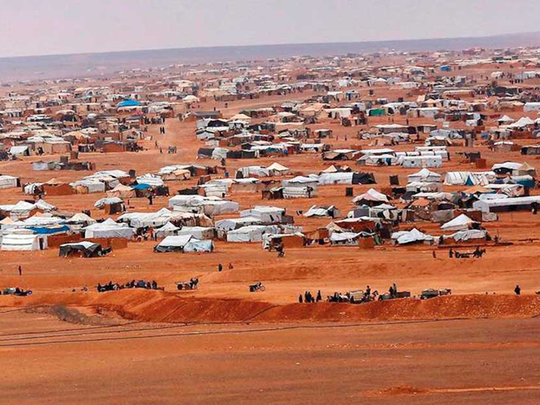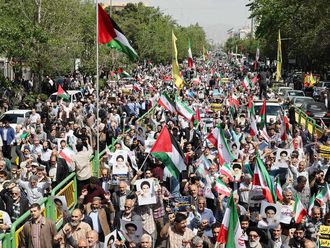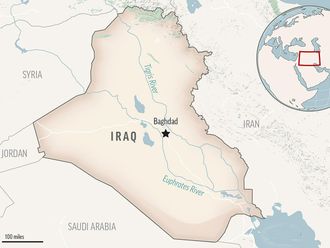
Rukban Camp, Syria: In a stretch of desert in southern Syria on the border with Jordan, a sandstorm battered the shelters of some 50,000 displaced people in a makeshift camp already running low on food, clean water and medical care.
The weather is only one of many concerns for the increasingly desperate families in Rukban camp. The United Nations warned that humanitarian conditions have reached a critical level, and aid groups are scrambling to reach the area.
A convoy is scheduled to reach Rukban on Thursday after receiving clearance from the Syrian regime. But a long-term plan for relief remains elusive.
The camp sprang up in a demilitarised zone between the two countries as tens of thousands of people fled the devastation of war in Syria - many from areas where Russian- and US-backed forces were fighting Daesh. They found themselves blocked from entering Jordan.
So they have stayed in Rukban instead, some for years. The UN refugee agency estimates that 80 per cent of the people here are women and children.
“The overall humanitarian situation inside the Rukban camp is at a critical stage,” said Ali Al Za’tari, the top UN official in Damascus.
About half of Syria’s population has been displaced by the ruinous civil war, and hundreds of thousands have been killed. What began as a popular uprising against Bashar Al Assad’s authoritarian rule more than seven years ago then devolved into a multisided war that dragged in international powers, including the United States and Russia.
Last week, Unicef reported that at least two children had died in the camp over a 48-hour period and issued an urgent appeal for aid. The two children, a 5-day-old boy and a 4-month-old girl, died in the camp where there is no access to intensive medical care.
The UN refugee agency runs a clinic on the Jordanian side of the border, but it is not always accessible.
Reached by phone, those living in the Rukban camp described a desperate situation. Shukri Shehadi fled the city of Palmyra with his six children, some of them adults with their own families, three years ago. He has been in the camp ever since.
“The situation is bad,” he said. “You could write a book about the misery here. Every day, every hour, we have sad stories.”
Shehadi described how a recent sandstorm had damaged tents and some makeshift clay huts. He said roofs were ripped off some of the huts, and the tents were damaged. Videos taken this week show the sand-whipped scenes inside the camp.
Imad Al Ghali, another camp resident, fled his town near Homs more than three years ago. He has lived in a tent in Rukban since then, separated from his wife and young daughter who are living in an area controlled by government forces.
“The biggest challenge in the camp is to find food,” Ghali said in a voice message, the wind howling in the background. “I saw a girl looking for food in the garbage.”
Video taken in the camp shows two small children digging through scattered trash. Ghali said many people had died in Rukban from lack of food and medicine. Others have detailed how pregnant women have died in the camp without proper medical care.
“We don’t have doctors here, and people here are poor. They depend on aid that is coming from the UN and NGOs,” Ghali said, worrying that the camp could face a “humanitarian catastrophe.”
The deteriorating conditions in the camp are a product of the conflict playing out around it. In recent months, the Syrian army has tightened restrictions on goods coming in and out of the area, preventing local aid groups and traders from accessing the area.
The site is inside a demilitarised zone set up for miles around Al Tanf base, where US-backed forces have maintained a presence and coordinated air strikes by the US-led coalition battling Daesh.
Last month, 100 Marines were sent to the base, intended to send a signal to the Syrian regime and its Russian allies that they were there to stay. The Russian military twice warned the Pentagon - on September 1 and 6 - that it would attack what it said were Daesh militants in the stretch of desert nearby.
The UN plans to send a humanitarian convoy to the camp, in partnership with the Syrian Arab Red Crescent, which is expected to reach the camp Thursday, according to a spokesman for the UN humanitarian coordinator in Damascus.
But there does not appear to be a long-term plan to address the humanitarian crisis. The convoy will carry food, water and some medical supplies, as well as plastic sheeting and clothes.
“While the UN-supported clinic near the border inside Jordan continues to provide basic health services for urgent lifesaving cases, more sophisticated health care is required,” Geert Cappelaere, UNICEF’s regional director for the Middle East and North Africa, said in a statement.
“The situation for the estimated 45,000 people - among them many children - will worsen further with the cold winter months fast approaching, especially when temperatures dip below freezing point in the harsh desert conditions.”
This year, Jordan allowed an aid shipment from the United Nations to pass through its border, but has since said that all aid to the area must come from the Syrian side of the border.












